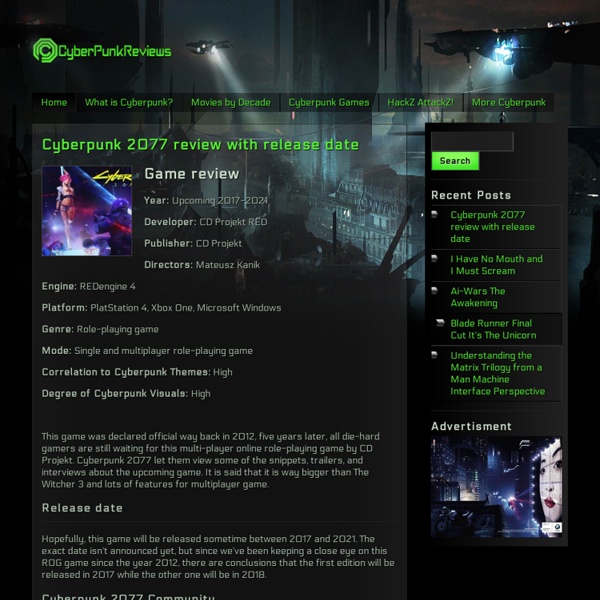



http://www.cyberpunkreview.com/
Related: Science Fiction & FantasyHow to Build a Universe That Doesn't Fall Apart Two Days Later First, before I begin to bore you with the usual sort of things science fiction writers say in speeches, let me bring you official greetings from Disneyland. I consider myself a spokesperson for Disneyland because I live just a few miles from it—and, as if that were not enough, I once had the honor of being interviewed there by Paris TV. For several weeks after the interview, I was really ill and confined to bed. I think it was the whirling teacups that did it. Sony Font Hack: How to Change Fonts on a Sony Reader This post will explain how to add different fonts to any Sony Reader and how to override the CSS file in a DRM-free ebook to display those fonts. For DRM encrypted ebooks you have to strip the DRM for this method to work. It only takes a few minutes to get this up and going if you already have Calibre installed on your computer. If not, you’ll need to start with this post: getting started with Calibre. This Sony font hack comes via this PDF from the good folks at the MobileRead forums.
thunderbolts of the Gods [Archive] - Cosmoquest Forum Without reading the book I cannot say much but it seems pretty far out to me. I would like to know how they try to prove this theory. Seems to me that is the planets were "looming" over us, then we would be subjected to intense gravitational tides, Radiation, dodging their moons etc. I would also be interested in seeing how they attemt to explain why the planets are in far orbits. As far as multiple cultures having similarities in their lore goes, well remember, it is threorized we all migrated out of Africa back in the day.
A Visual Timeline of AI Predictions in Science Fiction As anyone who’s started a company knows, choosing a name is no easy task. There are many considerations, such as: Are the social handles and domain name available?Is there a competitor already using a similar name?Can people spell, pronounce, and remember the name?
generators Charybdis is designed to simulate the production and decay of black holes in hadron collider experiments, according to theories with TeV-scale gravity and extra spatial dimensions. The production of the black hole is assumed to take place with a basically geometrical cross section. The decay then takes place via Hawking radiation using the D-dimensional grey-body factors. There is now a new version of Charybdis including many new physics features which can be obtained here and we recommend for all new physics studies. If you use the code please reference
10 Great Post-Apocalyptic Science Fiction Novels Books It’s a classic theme of science fiction: something really, really bad happens, and mankind is knocked back to the Stone Age. Of course, with the dropping of atomic bombs by the U.S. to end World War II, people came to realize that for the first time Man himself possessed the power to bring about a global cataclysm. And science fiction wasted no time in examining the possible effects (there were speculative stories in print well before the Manhattan Project was even conceived).
The Tesla Mystique Nikola Tesla, The Philadelphia Experiment, HAARP and Other Folklore Article by George B. Trinkaus, © 2008. Republished with permission. Your Picks: Top 100 Science-Fiction, Fantasy Books More than 5,000 of you nominated. More than 60,000 of you voted. And now the results are in. Wikipop iPads and Visitor Metrics Now that Seductive Subversion has closed, it’s time to look at the Wikipop project and report on what we’ve seen in the galleries over the run of the exhibition. In general, we believe this was one of our more successful interactives in the gallery, but want to remember that this is new and very attractive hardware; many visitors to the gallery reported that this was their first experience playing with an iPad and that alone is enough to boost traffic. With over 32,000 visitors to the show, we had roughly 12,000 sessions on the iPads and that meant that a fairly high percentage of visitors to the show used the devices [and giant disclaimer follows in the next paragraph, so please read it carefully]. More often than not, visitors were browsing the iPads in groups.
The Borderland of Science This day being July 10, 2012, we take a moment now to mark the birth of Nikola Tesla, a man who is known by many for his work in the development of Alternating Current, for his quirks of character, for being an “enemy” of Thomas Edison, and for being a vampire on a science-fiction television program. Hailed as a “geek icon”, Tesla may be more well-known today than any time since his death, but how many are interested in the work he was actually pioneering on the borderland of science, work that is now largely relegated to the fringe? While we may applaud his development of alternating current and radio, or marvel at the effects of Tesla coils and plasma lamps, these must be seen as the beginnings, and not the ending, of what are Tesla’s great contributions to science and society, and there is much left to be learned from his research. As far as we appear to have come, there is further to go if we are to understand, recreate, and expand on the theories and technologies he envisioned.